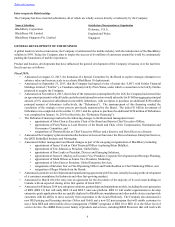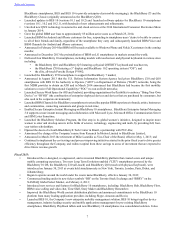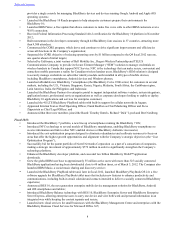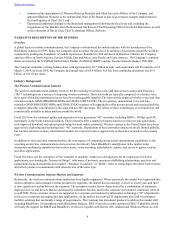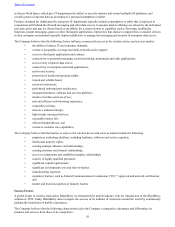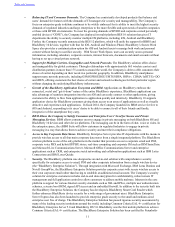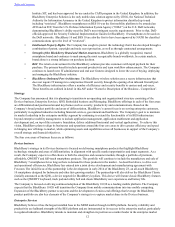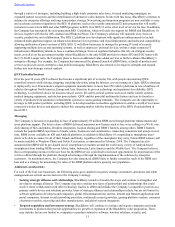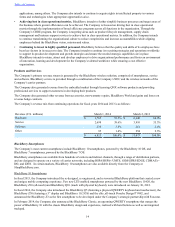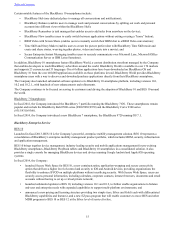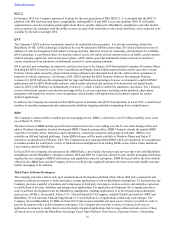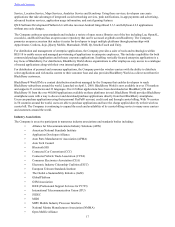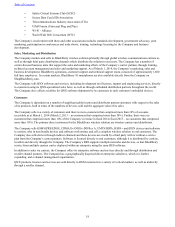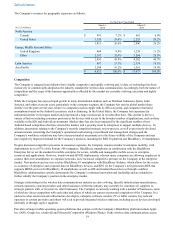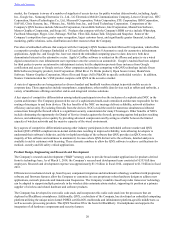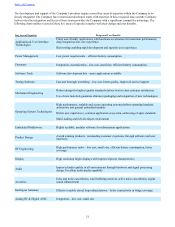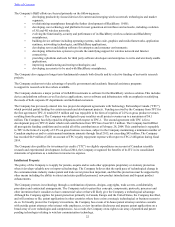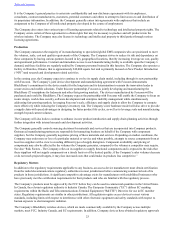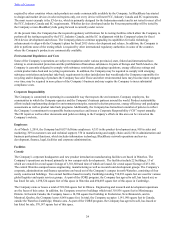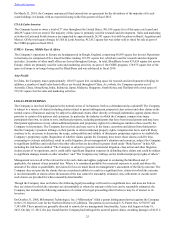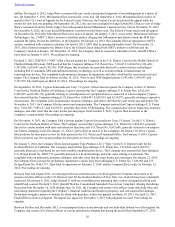Blackberry 2014 Annual Report Download - page 24
Download and view the complete annual report
Please find page 24 of the 2014 Blackberry annual report below. You can navigate through the pages in the report by either clicking on the pages listed below, or by using the keyword search tool below to find specific information within the annual report.
16
BES 12
In February 2014, the Company announced its plans for the next generation of BES, BES 12. It is intended that the BES 12
platform will offer backward and future compatibility, unifying BES 10 and BES 5 on to one platform. BES 12 will enable
organizations to develop enterprise-grade applications that are quickly deployed to BlackBerry smartphones and other mobile
devices and provide customers with the ability to move securely from on-premise to the cloud effortlessly, and is expected to be
available by the end of calendar 2014.
QNX
The Company’s QNX software is primarily aimed at the embedded systems market. It is also the technology behind the
BlackBerry 10 OS. QNX technology is deployed by over 40 automotive OEMs in more than 250 vehicle platforms in tens of
millions of vehicles throughout North America, Europe and Asia. Based on its proven technology and reputation for reliability,
QNX technology is a preferred choice for mission-critical, secure, life safety-critical systems such as air traffic control systems,
medical imaging equipment, and nuclear power plants. QNX enables powerful multimedia features and can be found in a
variety of products from automotive infotainment systems to casino gaming terminals.
QNX unveiled new technology in automotive and cloud services at the January 2014 International Consumer Electronics Show,
including the QNX Acoustics Active Noise Cancellation and Engine Sound Enhancement products which can remove sound
from the vehicle cabin caused by advanced fuel saving techniques and add sound back into the cabin to allow automakers to
brand the in-vehicle experience. In February 2014, QNX launched the QNX Neutrino Software Development Platform
(version 6.6), QNX Software Development Kit for Apps and Media (incorporating a browser environment to enable HTML5
applications and the QNX Multimedia software, which enables playback and indexing of both physical and digital media
sources), QNX CAR Platform for Infotainment (version 2.1), which is built to enable the automotive electronics Tier 1 industry
to move faster from concept to production and supports the in-car user experience including media playback, smart phone
integration with hands free systems, voice recognition, vehicle health, with applications environment support for certain
Android applications.
In addition, the Company also announced that QNX expects to introduce the QNX Cloud platform in fiscal 2015, a cloud-based
machine-to-machine management and communication platform targeting embedded computing device manufacturers.
BBM
The Company’s instant mobile to mobile private messaging service, BBM, is utilized by over 85 million monthly active users
(as of March 25, 2014).
The latest release of BBM includes powerful innovations such as free voice calling over Wi-Fi, one-click sharing of files and
photos, Dropbox integration, location sharing and BBM Channels, among others. BBM Channels extends the popular BBM
experience to brands, artists, businesses and communities, connecting consumers and groups in real-time. BBM is now
available on iOS and Android platforms. Future BBM releases will be made available to Windows Phone and Nokia X
customers, as announced in February 2014. The Company has also announced that BBM will be pre-loaded on LG smartphones
in markets around the world and a variety of Android-based smartphones from leading OEMs across Africa, India, Indonesia,
Latin America and the Middle East.
In fiscal 2014, the Company also announced the eBBM Suite, a new family of products and services that work with BlackBerry
smartphones and the BlackBerry enterprise solution, BES and BES 10, to provide enterprise-class mobile messaging that brings
together the core strengths of BBM with features and capabilities aimed at enterprises. BBM Protected will be the first solution
offered in the eBBM Suite and the Company believes it will provide regulated industries the most secure and reliable real-time
mobile messaging in the industry.
Third Party Software Developers
The Company provides a feature rich open standards-based development platform which allows third party commercial and
enterprise software developers to build and deploy custom applications to run on BlackBerry smartphones. To facilitate this, the
Company provides a number of products and technologies to third party developers, wireless carriers and enterprise customers
to enable them to develop, distribute and manage these applications. For application development, the Company provides a
suite of software development tools for BlackBerry smartphones, enabling applications to be developed using technologies
such as Java, HTML5, Javascript®, Native C/C++/Qt with OpenGL® ES support, Adobe® Flash® and Adobe® AIR® and
BlackBerry 10 will run most Android Gingerbread 2.3.3 and JellyBean 4.2.2 applications without any code changes. The
Company released BlackBerry 10 SDKs in fiscal 2013 built on open standards and open source wherever possible in order to
provide developers with a rich development experience. The Company also provides a variety of advanced services to
application developers to enable them to develop deeply integrated applications that leverage online network services. These
advanced services include the BlackBerry Messenger Social Apps Platform, Push Service, Payments Service, Advertising
Table of Contents


